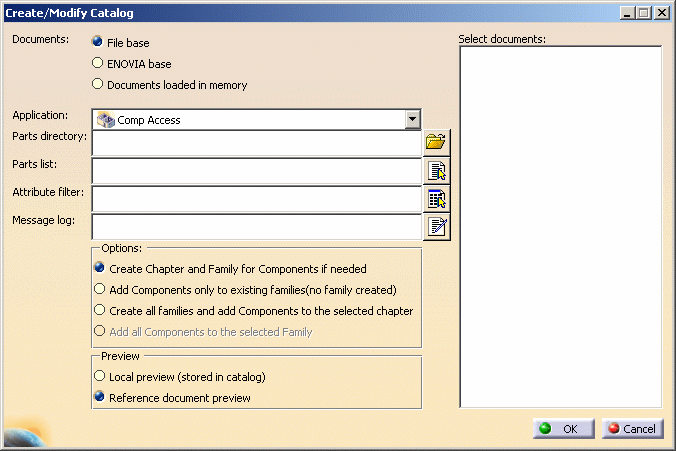 |
This task explains how
to modify a catalog. |
 |
Modifying refers to
adding a new part you have created to a catalog, or updating a catalog
after changing the attribute values of a part. In the example below a new
part - belonging to a new chapter and family - will be added to a catalog.
You can also select other options, as explained below. |
 |
1. |
Place the part you created in the
directory to which the catalog points. If you are modifying a part it will
already be in that directory. |
|
2. |
Create a text file (give it any
name you want), with a text editor like Wordpad, and enter the name of the
new part you want to add or the part you have modified. In this example the
part to be added is: M_EXPJNT_FL-RF.CATPart. Enter each part on a separate
line. |
|
3. |
Enter the workbench to which the
catalog belongs. Click File - Open and navigate to the catalog you want to
modify. It opens in the Catalog Editor. Activate (by double-clicking)
the root chapter of the catalog (for example Piping Part in Piping
Design). If you want to add parts to a particular chapter or family then
activate only that chapter or family. |
|
4. |
Click the Create/Modify
Catalog
button  . The
Create/Modify Part Catalog dialog box displays. . The
Create/Modify Part Catalog dialog box displays.

- If the parts are stored on a file
system then select File Base and follow the steps below.
- If they are stored
in ENOVIA then select ENOVIA Base and enter the names of all parts in a
text file as explained in Step 2.
- You can also load all parts in memory (if
they are in the catalog), in which case they will display in the Select
Documents window, and select the parts to process. (To load into memory,
first open the catalog, then click File - Desk, all the lines display,
select the lines, right-click on the selected line and select Open in the
drop down menu.)
Select one of the following options:
- Create Chapter and Family for Components
if needed: If you have a
part whose family or chapter does not exist in the catalog, then one
will be created.
- Add Components only to
Existing Families (no family created): If you want to add parts only to existing chapters and families then
check the Add Components to Existing Families checkbox. In the
specifications tree, select the chapter or family to which you want to add
(or modify) parts (you need to do this before you click the
Create/Modify Catalog button). As an example, if you select the chapter
Fitting shown in Step 8, then new parts will only be added to the existing
families. New families will not be created, even if your parts
list contains them. Parts will not be added to any other chapter.
- Create all Families and
Add Components to the
Selected Chapter: All
parts in the parts list will be added under the selected chapter,
regardless of which chapter it belongs to. If the parts belong
to families that do not exist under the selected chapter, then they
will be created.
- Add all Component to
the Selected Family: All parts will be added to
the selected family. All parts in the parts list will be added to the
selected family. The option is only enabled when you activate a
family.
- Local preview: The preview you see is of the part stored in the
catalog.
- Reference document preview: The preview you see is of the reference
document to which the part points.
|
|
5. |
Select the application in which
you want to modify the catalog by clicking the down arrow in the
Application field. |
|
6. |
Click the button next to the Parts
Directory field and navigate to the directory where your parts are stored.
The default location is ...intel_a\startup\\EquipmentandSystems\XXX\XXXX\ComponentCatalogs\Parametric,
where XXX\XXX
is the application, such as Piping\PipingDesign. |
|
7. |
Click the button next to the Parts
List field and navigate to the text file you created, containing the names
of new and modified parts. Click OK to begin modifying the catalog, which
may take a few minutes. A dialog box will inform you of the progress. |
|
8. |
The part M_EXPJNT_FL-RF is added
to the catalog. The family to which it belongs did not exist in the catalog
so the family is also created. The chapter (FITTING) to which it belongs
exists in the catalog so it is placed under that chapter.

|
|
 |


![]()